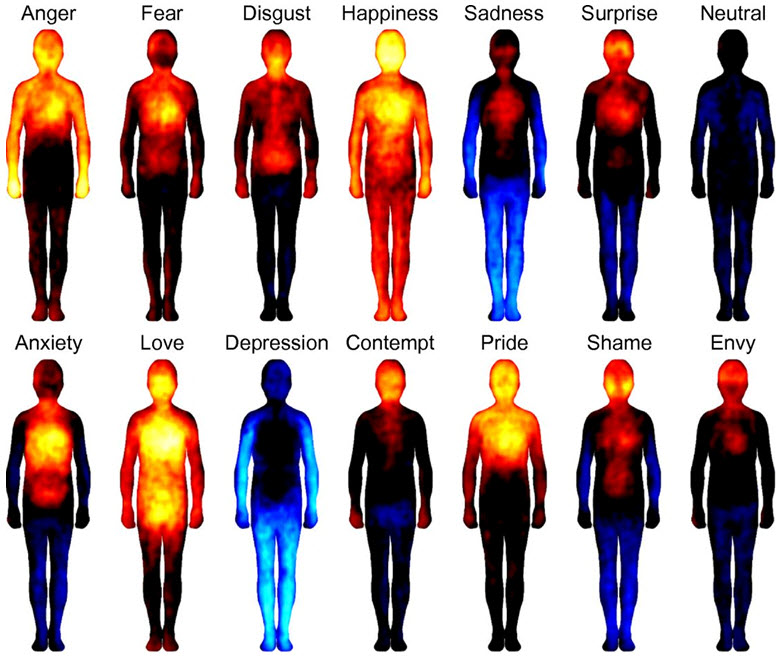Feb 09, 2014
Bodily maps of emotions
Via KurzweilAI.net

Bodily topography of basic (Upper) and nonbasic (Lower) emotions associated with words. The body maps show regions whose activation increased (warm colors) or decreased (cool colors) when feeling each emotion. (Credit: Lauri Nummenmaa et al./PNAS)
Researchers at Aalto University in Finland have compiled maps of emotional feelings associated with culturally universal bodily sensations, which could be at the core of emotional experience.
The researchers found that the most common emotions trigger strong bodily sensations, and the bodily maps of these sensations were topographically different for different emotions. The sensation patterns were, however, consistent across different West European and East Asian cultures, highlighting that emotions and their corresponding bodily sensation patterns have a biological basis.
The research was carried out on line, and over 700 individuals from Finland, Sweden and Taiwan took part in the study. The researchers induced different emotional states in their Finnish and Taiwanese participants. Subsequently the participants were shown pictures of human bodies on a computer, and asked to color the bodily regions whose activity they felt increasing or decreasing.
“Unraveling the subjective bodily sensations associated with human emotions may help us to better understand mood disorders such as depression and anxiety, which are accompanied by altered emotional processing, autonomic nervous system activity, and somatosensation (body sensations),” the researchers said in an open-access paper in Proceedings of the National Academy of Sciences. “These topographical changes in emotion-triggered sensations in the body could provide a novel biomarker for emotional disorders.”
Abstract of PNAS paper
Emotions are often felt in the body, and somatosensory feedback has been proposed to trigger conscious emotional experiences. Here we reveal maps of bodily sensations associated with different emotions using a unique topographical self-report method. In five experiments, participants (n = 701) were shown two silhouettes of bodies alongside emotional words, stories, movies, or facial expressions. They were asked to color the bodily regions whose activity they felt increasing or decreasing while viewing each stimulus. Different emotions were consistently associated with statistically separable bodily sensation maps across experiments. These maps were concordant across West European and East Asian samples. Statistical classifiers distinguished emotion-specific activation maps accurately, confirming independence of topographies across emotions. We propose that emotions are represented in the somatosensory system as culturally universal categorical somatotopic maps. Perception of these emotion-triggered bodily changes may play a key role in generating consciously felt emotions.
21:57 Posted in Emotional computing, Research tools | Permalink | Comments (0)







The comments are closed.